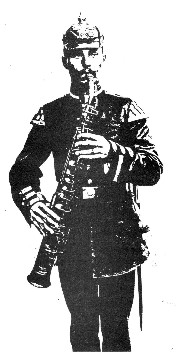Heckelphone-clarinet: Difference between revisions
Link to diagram, xref to heckelphone and heckel-clarina |
NDCompuGeek (talk | contribs) m minor updating with layout tweaking |
||
| Line 1: | Line 1: | ||
[[Image:Hpcl.jpg|right|thumb|A musician playing a heckelphone-clarinet.]] |
[[Image:Hpcl.jpg|right|thumb|A musician playing a heckelphone-clarinet.]] |
||
The '''heckelphone-clarinet''' (or Heckelphon-Klarinette) is a rare [[woodwind instrument]], invented in 1907 by Wilhelm Heckel in [[Wiesbaden-Biebrich]], [[Germany]]. Despite its name, it is essentially a wooden [[saxophone]] with wide conical [[bore (wind instruments)|bore]], built of red-stained maple wood, [[overblowing]] the octave, and with [[clarinet]]-like fingerings. It has a [[Single-reed instrument|single-reed]] [[mouthpiece (woodwind)|mouthpiece]] attached to a short metal neck, similar to an [[alto clarinet]].<ref name="dullat">{{cite book |
The '''heckelphone-clarinet''' (or ''Heckelphon-Klarinette'') is a rare [[woodwind instrument]], invented in 1907 by Wilhelm Heckel in [[Wiesbaden-Biebrich]], [[Germany]]. Despite its name, it is essentially a wooden [[saxophone]] with wide conical [[bore (wind instruments)|bore]], built of red-stained maple wood, [[overblowing]] the octave, and with [[clarinet]]-like fingerings. It has a [[Single-reed instrument|single-reed]] [[mouthpiece (woodwind)|mouthpiece]] attached to a short metal neck, similar to an [[alto clarinet]].<ref name="dullat">{{cite book |last=Dullat |first=Günter |title=Klarinetten: Grundzüge ihrer Entwicklung |publisher=Bochinsky |date=2001 |location=Frankfurt am Main}}</ref> The heckelphone-clarinet is a [[transposing instrument]] in B{{music|flat}} with sounding range of D<sub>3</sub> (middle line of bass staff) to C<sub>6</sub> (two ledger lines above the treble staff), written a whole tone higher. <ref name="marcuse">{{cite book |last=Marcuse |first=Sibyl |title=Musical Instruments: A Comprehensive Dictionary |publisher=Norton |date=1975 |location= New York}}</ref> The instrument is not to be confused with the [[heckel-clarina]], also a very rare conical bore single reed woodwind by Heckel but higher in pitch and made of metal, nor with the [[heckelphone]], a double reed instrument lower in pitch. |
||
| last = Dullat |
|||
| first = Günter |
|||
| title = Klarinetten: Grundzüge ihrer Entwicklung |
|||
| publisher = Bochinsky |
|||
| date = 2001 |
|||
| location = Frankfurt am Main}}</ref> The heckelphone-clarinet is a [[transposing instrument]] in B♭ with sounding range of d (middle line of bass staff) to c (two ledger lines above the treble staff), written a whole tone higher. <ref name="marcuse">{{cite book |
|||
| last = Marcuse |
|||
| first = Sibyl |
|||
| title = Musical Instruments: A Comprehensive Dictionary |
|||
| publisher = Norton |
|||
| date = 1975 |
|||
| location = New York}}</ref> The instrument is not to be confused with the [[heckel-clarina]], also a very rare conical bore single reed woodwind by Heckel but higher in pitch and made of metal, nor with the [[heckelphone]], a double reed instrument lower in pitch. |
|||
==Timbre== |
==Timbre== |
||
The instrument sounds somewhat like a saxophone, but with a much softer tone. In his 1931 catalogue, Heckel asserts that "the clarinet-like tone of the instrument is excellent, extraordinarily harmonious, and powerful; nor is it sharp or metallic like that of the alto saxophone".<ref name="heckel">{{cite book |
The instrument sounds somewhat like a saxophone, but with a much softer tone. In his 1931 catalogue, Heckel asserts that "the clarinet-like tone of the instrument is excellent, extraordinarily harmonious, and powerful; nor is it sharp or metallic like that of the alto saxophone".<ref name="heckel">{{cite book |last=Heckel |first=Wilhelm |title=Über 100 Jahre Weltruf |publisher=Heckel |date=1931 |location=Wiesbaden-Biebrich}}</ref> It was apparently intended for military use, but never became popular, and only between twelve and fifteen were manufactured. |
||
| last = Heckel |
|||
| first = |
|||
| title = Über 100 Jahre Weltruf |
|||
| publisher = Heckel |
|||
| date = 1931 |
|||
| location = Wiesbaden-Biebrich}}</ref> It was apparently intended for military use, but never became popular, and only between twelve and fifteen were manufactured. |
|||
==References== |
==References== |
||
| Line 30: | Line 12: | ||
==External links== |
==External links== |
||
* [http://test.woodwind.org/clarinet/BBoard/download.html/1,908/Heckelclarina.jpg Diagram of heckelphone-clarinet], heckel-clarina, and saxophone from 1931 Heckel catalog. |
* [http://test.woodwind.org/clarinet/BBoard/download.html/1,908/Heckelclarina.jpg Diagram of heckelphone-clarinet], heckel-clarina, and saxophone from 1931 Heckel catalog. |
||
| ⚫ | |||
| ⚫ | |||
{{Single reeds}} |
{{Single reeds}} |
||
| ⚫ | |||
| ⚫ | |||
Revision as of 17:08, 27 July 2011

The heckelphone-clarinet (or Heckelphon-Klarinette) is a rare woodwind instrument, invented in 1907 by Wilhelm Heckel in Wiesbaden-Biebrich, Germany. Despite its name, it is essentially a wooden saxophone with wide conical bore, built of red-stained maple wood, overblowing the octave, and with clarinet-like fingerings. It has a single-reed mouthpiece attached to a short metal neck, similar to an alto clarinet.[1] The heckelphone-clarinet is a transposing instrument in B♭ with sounding range of D3 (middle line of bass staff) to C6 (two ledger lines above the treble staff), written a whole tone higher. [2] The instrument is not to be confused with the heckel-clarina, also a very rare conical bore single reed woodwind by Heckel but higher in pitch and made of metal, nor with the heckelphone, a double reed instrument lower in pitch.
Timbre
The instrument sounds somewhat like a saxophone, but with a much softer tone. In his 1931 catalogue, Heckel asserts that "the clarinet-like tone of the instrument is excellent, extraordinarily harmonious, and powerful; nor is it sharp or metallic like that of the alto saxophone".[3] It was apparently intended for military use, but never became popular, and only between twelve and fifteen were manufactured.
References
External links
- Diagram of heckelphone-clarinet, heckel-clarina, and saxophone from 1931 Heckel catalog.
